Cultivating Hemianthus Callitrichoides Emersed
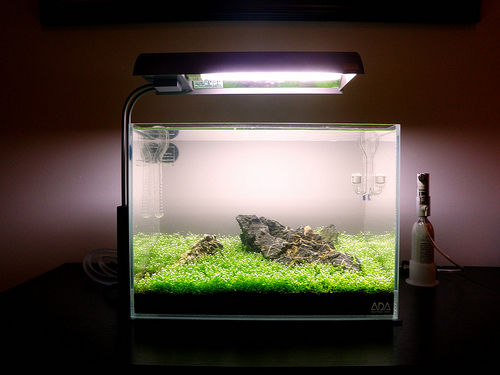
Iwagumi Padang - my planted tank
Yes, that is a carbon dioxide canister pumping CO2 underwater!
"Hemianthus callitrichoides, sometimes known as ‘dwarf baby tears’, or more commonly as ‘HC’, was discovered by Tropica founder Holger Windeløv during an expedition to a small rocky stream east of Havana, Cuba; it was described in aquaristic literature for the first time in 2003. Since its introduction into the hobby, HC has become increasingly popular and a foreground plant of choice, making this once rare plant moderately easy to obtain." - Aquatic Plant Central.
I was first introduced to the world of aquascaping and Iwagumi through Takashi Amano. The field captivated me with its blend of artistic expression and technical complexity. Among the aquatic plants I encountered early on, Hemianthus callitrichoides (HC) stood out as a favorite. As a beginner, I found scattered resources on HC cultivation but lacked a cohesive guide. This report is intended as a practical reference for anyone seeking to cultivate a dense carpet of HC successfully, particularly using the emersed method.
Emersed (Dry Start) or Submersed?
I opted to cultivate HC emersed rather than submersed for three key reasons:
- Faster growth: HC establishes a dense carpet more quickly in emersed conditions.
- Root stability: The roots grow deeper into the substrate, preventing frustrating floaters when flooding the tank.
- Algae control: Algae growth is minimized, allowing HC to dominate before flooding.
Tank and Lighting
For this project, I used a 20-liter (5.5-gallon) rimless tank paired with a 27W, 8000K compact fluorescent bulb. This setup provided ample lighting for HC, which thrives under high light conditions. Replicating the plant’s tropical habitat indoors was essential.
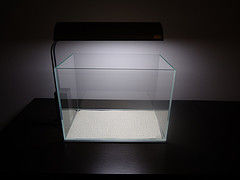
If you find yourself asking, “Do I have enough light?” the answer is likely no. As a rule of thumb, aim for at least two watts per gallon. More light is usually better; I achieved excellent results with the 8000K daylight spectrum bulb.
Substrate
The substrate consisted of three layers:
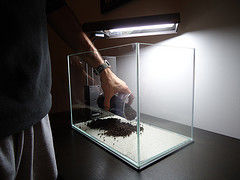 |
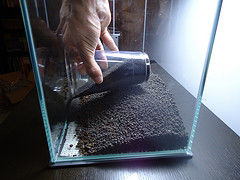 |
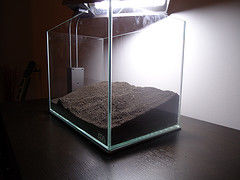 |
|---|
1. Bottom layer: ADA Powersand Special, a nutrient-rich base (fertilizer) layer with beneficial microorganisms.
2. Main substrate: A 4 cm layer of ADA Amazonia 1, Normal Type. I preferred this over Amazonia 2 for its durability and balanced chemistry. It also maintains its scape reasonably well once the tank is flooded.
3. Top layer: ADA Amazonia 1, Powder Type. Its finer granularity is ideal for HC roots.
Hardscape
After arranging the hardscape using Seiryu stones, I sprinkled additional Amazonia Powder soil to fill gaps and create a seamless, natural look.
Planting
Planting HC is a meticulous process that demands patience:
1. How many pots? For a tank this size, I used six to seven pots of HC. Starting with more pots accelerates the carpeting process. I kept the pots in a humid Ziploc bag as I slowly worked through the planting process.
2. Rock wool removal: I carefully removed the rock wool from the HC to avoid future issues with dirt or rot. Scissors can help here.
3. Planting technique: Using tweezers, I planted small clumps of HC about 5–10 mm apart in a uniformly moist substrate. To prevent flooding from excess watering, I used a mister to lightly spray the substrate. Tweezers made this delicate process significantly easier and more precise.

Humidity and Daily Routine
HC requires high humidity to thrive in emersed conditions. To maintain this, I covered the tank with clear saran wrap, which trapped humidity and retained heat from the lights.
Daily Routine:
- Morning: Unwrap the saran wrap, mist the substrate and hardscape, and reseal the tank.
- Evening: Inspect the tank for dryness without unsealing it. If needed, increase misting.
Photoperiod
I set my lights on a timer for 8-10 hours a day.
How Long Before I Get My Carpet?
Patience is crucial. It took about a month to achieve a dense HC carpet. Initial progress was slow, but consistency paid off as the plants rooted and spread.

Key Notes and Tips
- Avoid over-misting, as excess water can lead to flooding or algae growth.
- Keep the tank in a warm location, away from drafts.
- Replace the saran wrap every few days to prevent condensation from blocking light.
- Use filtered or dechlorinated water for misting.
Frequently Asked Questions, Concerns, and Fallacies
Will HC suffocate without a gap in the saran wrap seal? No. HC thrives with a tight seal. Daily misting provides sufficient airflow.
Is it okay to miss a day of misting? HC is highly sensitive. Missing a day can lead to drying and potential loss.
What if the soil floods? Excess water can hinder root growth and encourage mold. Use a syringe to remove pooled water.
Other Resources
External resources related to this article:
- Planted Tank Forums
- My Planted Tank discussions of progress
- Hemianthus Callitrichoides on Aquatic Plant Central
- Aqua Journal Online
Acknowledgments: Special thanks to Jordan Alexiev and Kimberly Phillips for their support throughout my experiments. I also gained invaluable insights from members of the Planted Tank forums. Note: I am not affiliated with ADA.
